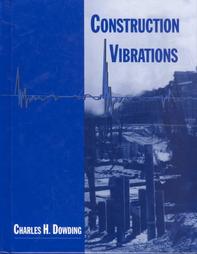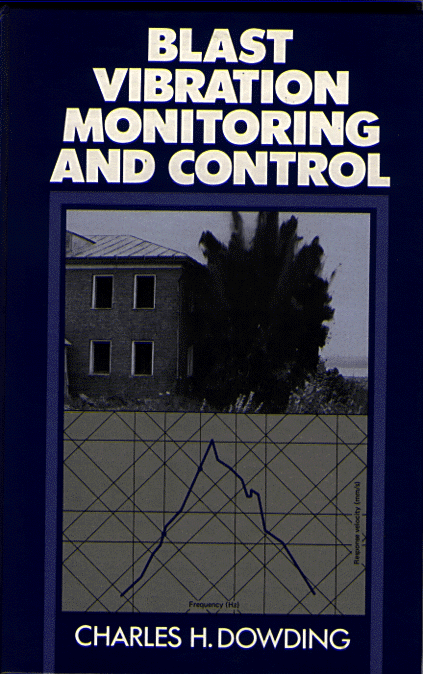Construction Vibrations Book
 
1. Ordering Information
2. Purpose of Book
3. Importace of Blasting Experience
4. Specifications, Software & Problem Solutions
5. Frequency Based Controls
6. Who Should Read This Book?
7. Why is Frequency Important?
8. Cosmetic Nature of Vibration Induced Cracking
9. What About Regulations?
10. Special Contributions
Ordering Information
Construction Vibrations is available directly from Amazon.com at this link:
Construction Vibrations on Amazon.com
Purpose of the Book
This book expands earlier work, published as Blast Vibration Monitoring and Control, pictured in the above right (Dowding,1985), to cover the entire field of construction vibrations. While the blasting book was well received and translated into Chinese and Japanese, it begged extension along a number of fronts in the field of construction. The new book contains roughly twice as much material as the original, which has been updated where necessary. New chapters are devoted to vibrations emanating from construction activities that span the field from conventional pile driving to novel explosive demolition. For a photo of explosive building demolition press here. Special chapters on response include topics ranging from micro vibration and its effect on sensitive electronics to vibratory slope stability
Importance of Blasting Experience
Blasting research forms an excellent foundation for understanding construction vibrations, since blasting is the most energetic and challenging of vibration producing construction techniques. As such it has attracted enough attention to justify considerable expensive field experimentation to allow scientific observation of the onset of cracking. Furthermore blasting experience forms the base for almost all specifications to control construction vibrations. For instance, while the chapter on specifications was being written no specifications were found for controlling pile driving vibrations that were not simply an extension of a blast vibration specification.
Specifications, Software & Problem Solutions
Three new chapters illustrate the new book's combined attributes of academic textbook and professional practice handbook. They are the chapters on construction specifications (26), software for calculating response spectra (31) and answered problems (Appendix A). Example problems and answers can be found here. Example specifications are included for pile driving, blast densification of sands, and demolition blasting as well as the expected sections on rock blasting and air over pressure & noise. The software, NUVIB 2, is an analytical package designed for the calculation of response and Fourier spectra from a wide range of digital and hard copy records. Finally, over 120 illustrative problems, included at chapter ends, are answered at the end of the book.
Frequency Based Controls
Frequency based control and analysis are specifically addressed on a practical level. Since adoption of frequency based control by the United States Office of Surface Mining and many members of the European Common Market, a concern has developed over the proper method of determining the dominant frequency. An entire chapter (10) has been devoted to this subject, and traces the historical development of the technique and compares three methods of determination.
Who Should Read This Book?
Since construction and blast vibrations are monitored and controlled by civil and mining engineers, contractors, regulators, as well as, geophysicists and engineering geologists, this book should be of interest to a broad spectrum of readers. The very diversity of the group challenges the organization of the book. Geologists have the greatest interest in the transmission of the vibration through the rock and soil, contractors and their engineers are interested in the effects of equipment and blast design on the resulting vibration, and regulators and their engineers are interested in building response and control of the procedures. All of these needs are addressed in this book.
Why is Frequency Important?
The underlying theme of this book is the importance of frequency. Research in structural dynamics has shown that structures respond differently when excited by vibrations, equal in all respects, but differing in principal frequency. A residential structure will respond less to a 12 mm/s (0.5 in./sec) ground motion with a principal frequency of 80 Hz than one at 10 Hz. Therefore, the 80 Hz motion is less likely to crack the structure than the 10 Hz motion.
Recognition of the importance of frequency has led to the necessity of adopting a vibration monitoring approach that includes frequency. The simplest is based upon the single degree of freedom (SDF) model for above-ground structures and ratio of excitation wave length to structure size for below-ground structures. The SDF model is normally employed through the response spectrum, and relative wave length considerations are employed through a knowledge of the propagation velocity of the medium around buried structures.
The response spectrum, the basis of frequency based criteria, is constructed from calculated responses of systems that are mathematically equivalent to a heavy weight dangling from a chain of rubber bands. This simple model, which can be built at the reader's desk while studying this book, is employed in Chapter 5 to explain how response spectrum integrates considerations of vibration intensity and frequency.
Cosmetic Nature of Vibration Induced Cracking
The minute size of the hairline cosmetic cracks that define the threshold of cracking, their irrelevance in structural stability, and the difficulties posed by their observation are almost always forgotten in discussions of vibration-induced cracking. Press here for a photo of a cosmetic crack that was produced by ground motions with a maximum particle velocity of 185 mm/sec.
Occurrence of vibration-induced cracking at regulatory limits is based upon the visual observation of cosmetic cracks because these hair-sized cracks occur at the lowest vibration levels. All homes contain many cosmetic cracks, and distinction between vibration-induced and naturally occurring cosmetic cracks is extremely difficult and time-consuming. Since structures crack naturally, recording of cosmetic cracks immediately before and after blasting is essential to isolate those that are blast-induced.
A comparison of strains in walls produced by blast vibrations and everyday events with those needed to cause threshold-size cracks in wall-covering materials gives perspective to the observation of cracking at low vibration levels. Recent measurements show that in the course of daily life an active family or active occupants of historic buildings will produce strains in walls similar to those produced by blasting vibrations of 2.5 to 12 mm/s (0.1 to 0.5 in./sec). The most astonishing measurements were the relatively enormous wall strains caused by daily changes in temperature and humidity. These alone are large enough to crack plain plaster. A special chapter has been devoted to these environmental considerations.
What about Regulations?
No attempt has been made to reconcile the wide variation of regulations between countries. However, the basic scientific studies that form the data base for regulatory decision making are presented and compared. A thorough understanding of these studies will allow an assessment of the conservatism in any regulation.
Regulations by their nature are conservative limits selected in a process that is not isolated from political concerns. The political concerns generally are focused on the determination of the socially acceptable probability of the occurrence of cracking. Recently, human annoyance has become an important issue in repeated blasting. Annoyance is distinct from cracking although it may affect the choice of regulatory limits.
Special Contributions
Special thanks to those colleagues from around the world whose collaboration provided the bulk of the material presented in the following chapters. Their electronic contact information has been provided when possible.
Response Spectra and Structural Response
Dr. R.T. Langan - California, USA Chevron Oil rtl@chevron.com
Resonance, Higher Mode, and Traveling - Wave Response
Prof E. Rossow - Illinois USA Northwestern University e-rossow@northwestern.edu
S.W. Mncwango - South Africa
Cosmetic Cracking and its Documentation
P. Corser - Colorado, USA Terramatrix, Inc. corser@terramatrix.com
Air Blasts and Construction Noise
Dr. C. Fulthorpe - Texas, USA University of Texas
Pile Driving
Dr. K.M. O'Connor - Minnesota, USA Geotdr geotdr29@mirage.skypoint.com
Impacting, Vibrating, Rotating, and Rolling Construction Equipment
F. Blais - France
Explosive Demolition
Y. Sofrin - Israel
Vibration Stability of Rock Slopes
Dr. C. Gilbert - France Soletanche
Blast Densification of Sand
Prof. Roman Hryciw - Michigan, USA University of Michigan romanh@engin.umich.edu
Micro Vibrations, Equipment, Sensitivity and - Occupant - Induced Vibrations
H. Gatineau - France
Instrumentation and Microcomputers
H. Duplaine - Paris, France
Specifications for Control of Construction Vibrations
P. Santoni - Paris, France L. Berger, Intl. 101665.3712@compuserve.com
Blast Design
Prof. C. Aimone - New Mexico, USA New Mexico Institute of Technology caimone@nmt.edu
Analytical Software
Dr. Richard Claxton - Wisconsin, USA Applied Computational Analyses, Inc. rclaxton@execpc.com
Dr. F. C. Huang - California, USA American Geotechnics, Los Angeles
Gyo-Won Kim - Korea Daewoo
Jin-Young Park - Korea
Structural and Wall Response
K. Beck - Iowa, USA Terracon Consultants, Inc.
P. Murray - New York, USA Gilsanz Murray Steficek |